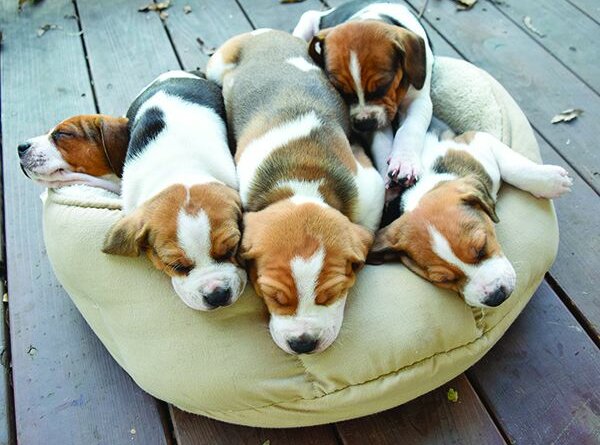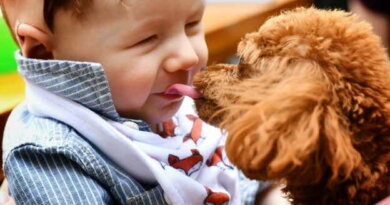Sleeping With Your New Puppy
I can’t tell you how many times I have heard this confession from an adopter of one of my foster puppies: “I know it’s wrong, but we allowed the puppy to sleep with us last night. I’ve read about how I must crate him. But he was crying! And he seemed so sad. And when we took him in with us he settled down and I finally got some sleep. But what should I do tonight?”
Almost every new puppy owner I counsel has searched the internet’s dog-training sites and emerged with the sternly delivered rule:
“Crate your new 8-week-old puppy at night. You’ll have to get up once or twice to let them out to go to the bathroom, but put them right back in. Ignore them when they cry. They’ll get used to it.” [Editor’s note: No one has ever read that on the WDJ site!]
If you have followed that advice and it’s working beautifully for you . . . fabulous. Happy trails. You can skip reading this.
If, however, this feels wrong to you, or you are dying to soothe your crying puppy, I’m here to give you permission to listen to your gut. Please do create a softer alternative for those first few nights. In fact, here’s the shocking advice I give to clients: If you want to, go ahead and bring that pup into bed with you. It’s what we do at our house, and here’s why.
HOW PUPPIES SLEEP
My family and I have now fostered close to 200 puppies, mostly moms with their litters. I spend countless hours watching the way puppies sleep and I can tell you this: It is never alone. It is in a warm, snuggled, co-breathing, ever-shifting pile of the beings they know and love best. There are puppy sighs, and – as they stretch – the sweetest little groans. Sometimes somebody staggers over for a cooler spot, but an hour later they’re back, burrowing into a nook they create just between their sister’s head and their brother’s butt. It is clearly bliss.
Alas, this can’t last forever, and one day, after two months spent sleeping exactly in this manner, the puppy goes “home” with his new humans. They are kind and responsible, and they are simply trying to follow expert advice when they take that confused puppy and stick him into a crate, alone, for hours, at night, with nothing to distract him. The puppy has nothing to do but miss his (real) family.
Of course he cries.
It’s not the end of the world. Eventually, probably, he will get over it. It might be in an hour, or a week, but eventually – probably – the puppy will sleep alone in the crate without crying (except for those pups who are triggered by their terror in a crate into developing separation anxiety). The “crate them right away” approach works fine for many, and it has its advantages. But there are other, kinder options.
BENEFITS OF CO-SLEEPING

At our house, when we have a pup just separated from the litter, we don’t do the alone-in-a-crate-all-night thing. Instead, we do our best to recreate that puppy pile they’re so used to, right in our own bed. We pop that puppy in between us. Soon enough, we are the littermates. After a very confusing first day without the comfort of her original family, you can almost feel the puppy sighing, thinking, “Okay, now this feels right.”
There is no crying, which means we get lots more sleep. Sure, we wake from time to time when the puppy readjusts, burrows in under an arm, or perhaps licks our face. But seriously? Those moments are delicious. If you are inclined to love that, don’t let that stern internet advice deprive you of one of the sweetest times in the world. Treat yourself, and your puppy, to six hours of easy bonding. You may well find that it advances your daytime interactions too.
WON’T HE PEE IN MY BED?
A big objection to this approach is that everyone’s sure the puppy will pee or poop in the bed. After all, when folks using a crate take the crying puppy out at 2 a.m., he always pees. They draw the conclusion that the pup was crying because he had to pee. Maybe! But more likely, he was crying because he was sad and lonely – most can easily hold it from 11 p.m. to 5 a.m.
How do I know? Because we do it all the time. With us, 8-week-old pups sleep soundly for those six hours with no bathroom break, happily snuggled into a family pile. Here’s how to make that happen:
✓ No food after 7 p.m.
✓ No water after 8:30. (Maybe a sip, but no big glugs.)
✓ Commit to a long, frisky play session outside just before bed. Not a quick step outside for a little pee, but a nice, action-filled adventure. (Motion encourages pees and poops!)
When we follow those rules, the puppies do not have to go out in the middle of the night. (The one exception is pups with diarrhea. If your pup doesn’t have a solid stool then this is risky indeed for obvious reasons.)
Mind you, once the pup truly awakens in the morning – more than just the reshuffling for a better spot, but walking around on the bed at 5 a.m. – it’s time to sprint into action. Jump out of bed – this is no time for your own bathroom break! Pick up that puppy and carry him outside quick. Whatever you do, don’t make the puppy walk to the door, because the motion of walking will mean “game over.” Carry the pup to the outdoor potty area and then be ready to reward him for what will naturally and quickly follow!
DON’T WANT TO SLEEP WITH A GROWN DOG?
Often folks are open to the idea of sleeping with a little puppy, but the idea of sharing the bed forever with a 70-lb grown dog is a hard “No!” They worry that once that barrier is broken, there’s no going back.
Not true. If you’d like, you can create a plan to transition the pup to the crate in a couple of weeks. By then, two incredibly important things will have happened:
1. Your pup will be happy at your house, understanding that you’re her new family.
2. You will have accustomed the pup to her crate with positive sessions during the daytime, so that she’s used to napping alone in there. It’s no longer such a big stretch to do it at night too. To make it easier, move an extra crate next to your bed, start using that every now and then during the day, and then one night – after a particularly adventurous, exhausting day – pop her in to sleep in there at night.
Perhaps you’re thinking, if she’s going to be sleeping alone in her crate soon, why not just bite the bullet and do it from the get-go? My answer is just … empathy. Surely you remember very sad moments of your life, times filled with fear. Just because they turned out okay later doesn’t mean they weren’t horrible. So why not keep your puppy from having that moment if you possibly can? Just because you know it’s all going to be okay doesn’t mean the puppy does.
FIRST NIGHTS ARE SCARY
After that first adjustment week, I find a crate absolutely indispensable for daily life with a puppy. And I’m also a big fan of letting a pup experience a slight feeling of discomfort before getting to the other side of a challenge. That builds confidence and resilience.
But when it comes to the very long night spent alone the exact moment the pup goes through the most shocking transition of her life? That’s one time where I’m going to err on the side of emotional comfort.




